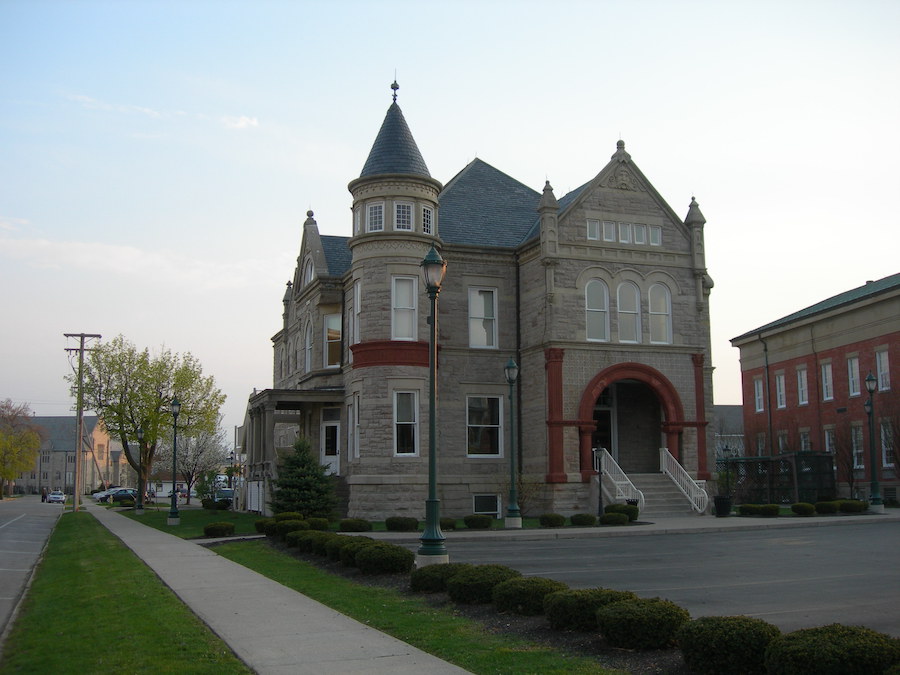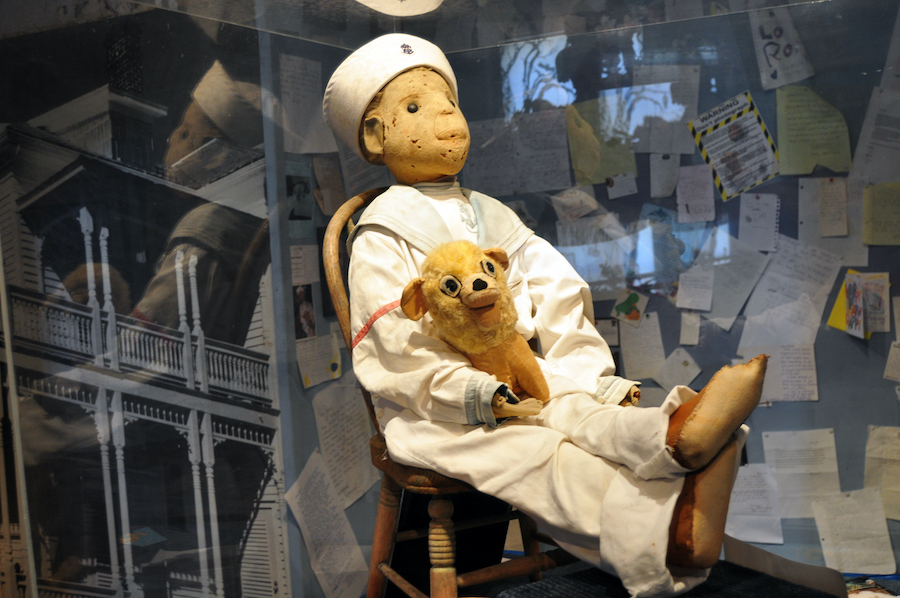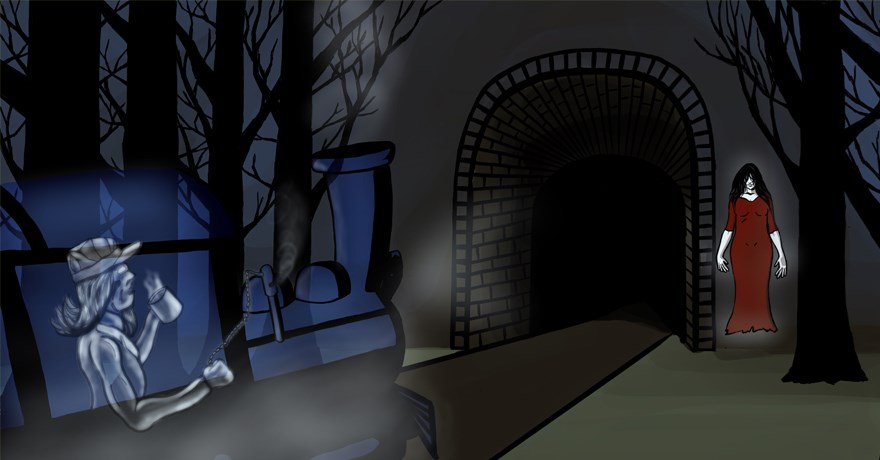Eight Creepy Cool Trailside Attractions

Rails-to-Trails Conservancy’s editorial team really loves Halloween.
For some much-needed levity (no pun intended) this spooky fun season, check out this list of some of our favorite creepy trailside attractions. And if you like this, don’t miss “10 Haunted Tales from America’s Trails.”
Special thanks to all the trail organizations and historical sites that participated in this post! Special acknowledgement also to RTC’s Tom Sexton, Laura Stark and Kevin Belanger.
1. Doll’s Head Trail – Constitution Lakes Park (Atlanta, Georgia)

Sure—one might consider a trail that contains artwork partially made from dismembered dolls a little creepy. But when it comes to the Doll’s Head Trail in Atlanta, we prefer to think of it as creepy—but for a great cause.
What started as a joke in 2011 by creator (and curator) Joel Slaton, a local carpenter, has become a popular art exhibit and way to clean up an area that had been denigrated by illegal dumping and regularly experiences flooding. Located at Constitution Lakes Park, a 125-acre nature preserve, just miles from downtown Atlanta in DeKalb County, Georgia, the 2.5-mile trail is composed of art found and formed from previously discarded items as well as trash that washes in from the South River. Yep—you will find an array of off-beat (and some spooky) doll vignettes, but the estimated 100 original pieces are also composed of anything and everything from bottles to old appliance parts and bicycles, to brickwork from the site’s former days as the South River Brick Company.
People are encouraged to use what they find in the park to create their own (family friendly please!) original pieces—no additional items are permitted to be brought in—with a goal of leaving the area better than they found it. The trail is located behind two lakes in a pedestrian-only accessible spot accessed via a paved trail and boardwalk. Birders may also appreciate spotting the dozens of bird species that nest in the park.
FYI: The TrailBlog recently chatted with Slaton about this unique site and its evolution from a fun personal project to a trail that is inspiring stewardship while garnering regional and national attention.
Note: For those who are seeking parking for the trail—do not attempt to use the trail’s GPS coordinates. Park managers request that you use the official parking lot, accessible at 1305 South River Industrial Blvd., Atlanta, GA. The park closes at dusk.

2. “The Exorcist” Steps – C&O Canal Trail (Washington, D.C.)

If you’ve ever had the stomach to watch the 1973 horror film “The Exorcist,” then you likely remember the climactic finale—set on a long dark stone staircase—in which Father Damien Karras has his famous good-versus-evil showdown with a demon masquerading as a 12-year-old girl named Regan MacNeil. Though the movie is (thankfully) fictional, the steps are real and can be found just a block or so away from the 184.5-mile Chesapeake & Ohio Canal National Historical Park in the historic Georgetown neighborhood, near the trail’s eastern terminus.
Providing a cut-through between Prospect Street NW and M Street NW where it turns into Canal Road, the stairs don’t look quite as spooky as they do in the film, but they do have a worthy history for rail and trail aficionados—having been part of the original Capitol Traction Station built at the end of the 1800s to serve streetcar companies. Designated as a D.C. historic landmark in January 2019, the stairs are a popular spot for runners and others seeking exercise who apparently haven’t been put off by Father Karras’ unfortunate experience.
(If you find yourself by the steps, which are not easily accessible except via foot or bike, you might give them a whirl and then cap things off in theme with a nice bowl of green pea soup.)
3. Paw Paw Tunnel – C&O Canal Trail (Near Oldtown, Maryland)

With a history stemming some two centuries, the C&O Canal towpath connecting D.C. and Cumberland, Maryland, is a corridor ripe with tales of the supernatural (one of the most famous being that of Edward’s Ferry and Haunted House Bend, covered in a previous post, “10 Haunted Tales from America’s Trails”).
One of the canal’s most impressive features is the 3,118-foot-long Paw Paw Tunnel, located between mile 155 and 156 of the C&O Canal towpath, which originally took 14 years to complete by the Chesapeake and Ohio Canal Company and was an alternative to following a 6-mile stretch of the Potomac River known as the Paw Paw Bends.
According to the C&O Canal Trust, the nonprofit organization that partners with the National Park Service to help restore and promote the canal, there are rumors of the trail being haunted. Some believe the spirit of a lockkeeper—an unfortunate casualty of clashes between workers constructing the trail—still roams through the dark tunnel. Additional activity has also been noted by paranormal specialists.
Whether or not one believes in spirits—what can be affirmed is that the tunnel is very very dark, and it is recommended that anyone who uses the tunnel’s walkway be sure to have a very sturdy flashlight or headlamp.
4. Historic Jail … and Dungeon – North Coast Inland Trail: Sandusky and Ottawa Counties (Fremont, Ohio)

“Few people know that there’s an 1840s dungeon hiding beneath the Sandusky County Courthouse” writes April Dray in a September 2019 article posted in Only in Your State. We at the TrailBlog whole heartedly concur; we didn’t know about this historic and somewhat macabre attraction that sits just two blocks from the 28-mile North Coast Inland Trail (Sandusky and Ottawa Counties), on Croghan Street in Fremont, Ohio.
Visitors can hear about the historic structure—including the jail, built in 1892, that is said to have ties to President Rutherford B. Hayes and is now on the National Register of Historic Places, as well as the dungeon beneath and its rather unsavory history as a punitive structure. A special adventure called “Dungeon Descent” is also offered for those who wish to explore the spirit world.
Although all tours and events are currently canceled due to COVID-19, you can still check out a pretty cool Virtual 3D Dungeon Tour on the Sandusky County Convention and Visitor’s Bureau’s website.
5. Robert the Doll – Florida Keys Overseas Heritage Trail (Key West, Florida)

Because we can’t seem to get enough of dolls …
At almost the southwestern tip of the Florida Keys Overseas Heritage Trail in Key West, right by the airport, you’ll find the Fort East Martello Museum. Heading westward, the trail provides adjacent stunning views of the water to your left; heading right over Highway A1A/S. Roosevelt Boulevard just after Faraldo Circle takes you directly into the Civil War-era fort, which was built in 1862 by the U.S. Army to protect Union-controlled Key West.
Today, the fort is home to exhibits about Key West history, from the Civil War to the Spanish-American War and the industries that were responsible for the area’s economic development. But by far the most popular exhibit is “Robert the Doll,” a uniquely handmade 40-inch doll created at the turn of the 20th century and initially owned by a boy named Robert “Gene” Eugene Otto.
Otto, who supposedly had conversations with the doll regularly as a child, and often blamed mishaps on him, became a prominent artist who helped design the gallery at the museum. After Otto passed away in 1974, Robert—which remained in his home, known as the Artist House—began exhibiting some pretty interesting behavior, including moving around, giggling, etc. Donated to the museum in 1994, Robert was eventually put on display, and it’s rumored that he continues his mischief, including frequently causing the malfunctioning of cameras and other electronic devices. (Apparently he doesn’t like to be photographed!)
6. Rockwood Mansion – Northern Delaware Greenway Trail (Wilmington, Delaware)

We were eerily thrilled to learn about this stunning Rural Gothic Revival in Wilmington, Delaware, right along the halfway point of the Northern Delaware Greenway Trail, the oldest and longest greenway trail in the state. Rockwood Mansion—part of the Rockwood Park & Museum—is a 170-year-old-ish estate that boast a number of stories from employees, volunteers and visitors who claim to have experienced the paranormal within its walls. The mansion, which is operated by Newcastle County and includes a carriage-house turned event venue, was built in 1851 as a retirement home for merchant-banker Joseph Shipley, and later served as a homestead for his nephew Edward Bringhurst’s family and generations of Bringhursts.
A cursory list of reports includes sightings of the apparitions of Joseph Shipley and family member Mary Bringhurst, who lived there for the duration of her life; the existence of the spirits of two young boys, Bobby and Eddie—the latter of whom likes to playfully push visitors—ghostly dog sightings; figures walking across hallways; shadows seen in the corner of one’s eye; footsteps; doors opening by themselves, etc. etc. Watch this video by the 301 and this clip from Ghost Hunters.
Paranormal tours are offered seasonally, but you can sign up for a variety of historical and cultural tours year-round in the park (check the website for details and COVID-related regulations), which is also just a beautiful standing legacy of the family and how people lived in the 19th and 20th centuries.
FYI: The grounds also serve as an official parking area, with restrooms, for the Northern Delaware Greenway Trail, and themselves include 2 miles of lighted walking trails throughout the park’s 72 acres.
7. Sleepy Hollow – Old Croton Aqueduct Trail (New York)

The New York Historical Society believes that for his character the Headless Horseman in the “The Legend of Sleepy Hollow,” published in 1819, American writer Washington Irving was inspired by the tale of a Hessian soldier during the Revolutionary War who unfortunately was decapitated by a cannonball at the Battle of White Plains around Halloween in 1776. Others believe he may have been inspired by “The Chase,” a translation of a 1796 poem by Gottfried Bürger.
We will never know what really inspired Irving, but we do know the Dutch-influenced Tarrytown area of New York—where he and his family moved during a Yellow Fever epidemic in 1798—would result in plenty of inspiration for what is considered one of the first ghost stories in America and which has been an inspiration on the literature world for 200 years.
Today, you can visit Sleepy Hollow—changed from “North Tarrytown” in 1996—which is nothing if not inspired by its famous literary heritage. Located right along the 26.5-mile Old Croton Aqueduct Trail (the often single-track dirt trail features an historic aqueduct built in 1842), the town has a variety of tour offerings, events and venues that celebrate all things Irving (and Ichabod). Notable venues include Irving’s estate, the Old Dutch Church and Burying Ground (the “purported haunt of the Headless Horseman”), and Sleepy Hollow Cemetery and the Headless Horseman Bridge.
Please be aware that the Old Dutch Church and is actively used and is infrequently opened to visitors outside of Fall. The Old Dutch Church burying ground and the Sleepy Hollow Cemetery (accessible from the rail-trail between the hours of 8 a.m. and 4:30 p.m.) are also both active; when touring, be respectful, and follow all cemetery rules and regulations.
Note: Many venues and events are closed currently due to the pandemic, or have limited visitor hours, facilities and services. Please research each venue carefully before you go. Special thanks to Visit Sleepy Hollow for assisting with this post!
8. Salem (Witch Trials) – Bridge Street Bike Trail (Massachusetts)

Rounding out our blog is certainly the most tragic of our listings—and the oldest, with a history going back more than three centuries. Many know that it was in Salem, Massachusetts, in 1692, when 19 people were hanged and one man pressed to death during one of the most infamous witch hunts in American history. The materialization of strange symptoms, including convulsions and hallucinations in two young girls (experts posit that it could have been ergot poisoning, often refuted, mass hysteria or physical ailments) initially would turn into full-blown accusations of witchcraft that impacted the lives of hundreds of people in the region and resulted in the deaths of 20.
Today, a memorial located in Historic Salem, about 0.4 mile south of the end of the 1-mile Bridge Street Bike Trail, pays respect to those who died. There are also many other opportunities nearby to explore the history of the trials—including several and museums and the “Witch House,” home of Judge Jonathan Corwin, who was involved in the events. Other trailside attractions for history and literature buffs include the Salem Maritime National Historic Site and the House of the Seven Gables, made famous by Salem resident and writer Nathaniel Hawthorne.

This article has been updated from its original 2020 version.

Donate
Everyone deserves access to safe ways to walk, bike, and be active outdoors.